A Private Tour today with a difference – having recently moved to Norfolk, the request from our guests was to visit some different sites slightly off the beaten track along the NE coast. We were not going to worry particularly about when we would be seeing in the way of birds today. It was a largely bright but cloudy day, but it stayed dry and we didn’t see any signs of the forecast showers until after we had finished up.
As we met in Wells, we started with a visit to the pools east of town. The Spoonbills were doing what Spoonbills like to do best – sleeping! They were right at the back of the water, by the far bank, but we could count at least 14 here this morning, a mixture of off-white adults and brighter white juveniles.
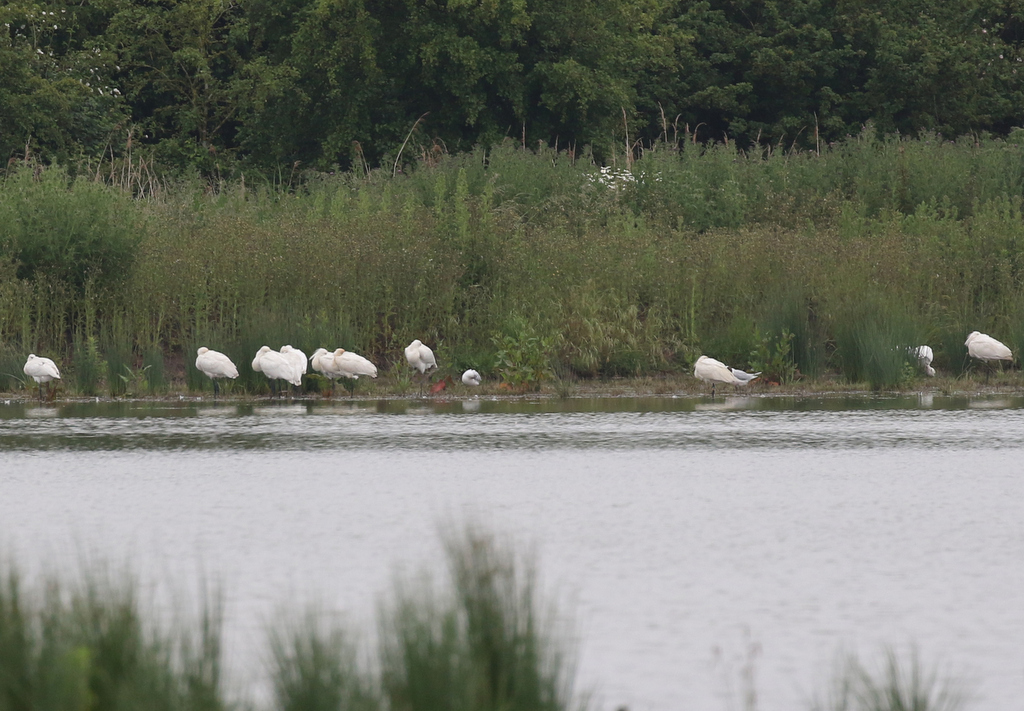
We walked down the track, where a Sedge Warbler was singing from the bushes. A family of Reed Buntings was in the long grass beyond the ditch, one of the juveniles flying to the fence in front of us calling.
The Egyptian Geese were still in the grass by the pool on the other side of the track and at least one pair of Shelducks had a large brood of growing shelducklings. There was a good number of (Eurasian) Teal here today, with birds already returning now from their breeding grounds further north. Otherwise, there were a few Gadwall, Mallard and Shoveler, the drakes now moulting into their drabber eclipse plumage.
There were several juvenile Avocets of various ages around the pools. They appear to be doing well, despite the limited attention paid to them by the adults. A couple of young Redshank were out in the middle too and there were still a few Lapwings visible in the long grass round the edge. We heard what sounded like a Spotted Redshank call towards the back at one point, but it was possibly flying over as we couldn’t see any sign of it.
The Grey Herons which have been doing their best to reduce the number of young birds on here were still around, being chased back and forth by the Avocets. One of the Grey Herons landed in the corner of the pools by the track, and immediately attracted the attention of one of an adult Lapwing which mobbed it relentlessly until it flew off again.

We continued on past the first pools, but as the seawall is closed for works at the moment, we turned left and walked through the grass towards the westernmost pool. There were more warblers in the reeds and bushes here. A couple of Reed Warblers flicking around in the hawthorns and a family of Sedge Warblers down in the vegetation beyond the sedges. We watched a recently fledged juvenile, still with a short tail, begging and eventually being fed by one of the adults. There were a few Common Whitethroats and a Lesser Whitethroat singing.
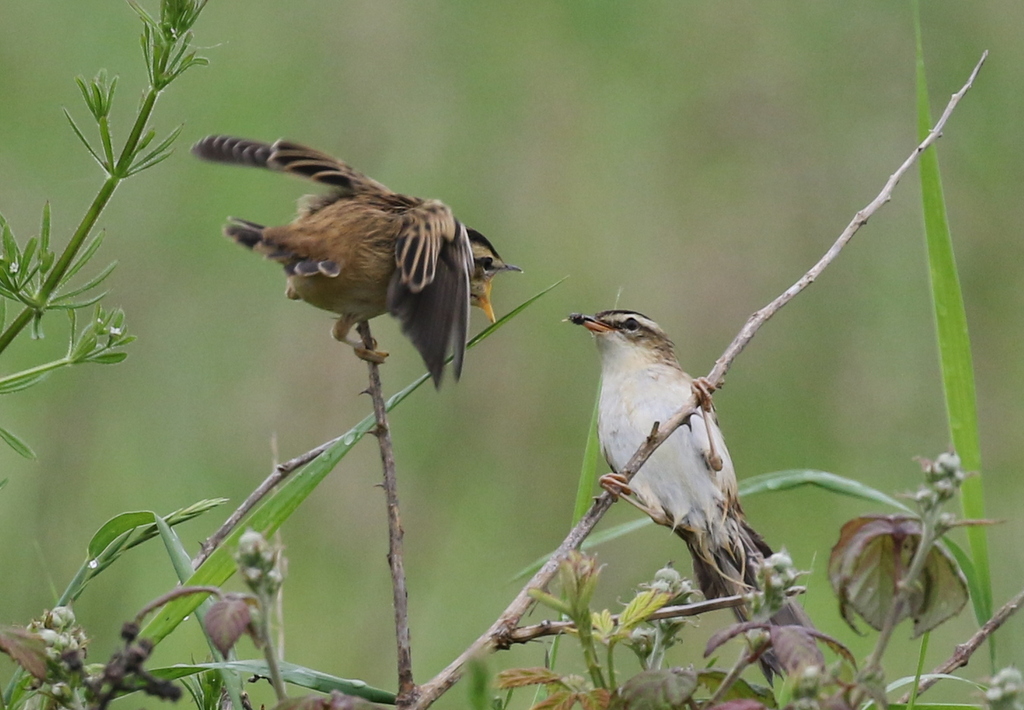
The pool at the end held a few more Avocets, Lapwings and a Redshank, but no sign of any Spotted Redshank here either. We made our way slowly back to the minibus, a Song Thrush was singing and flew up into the top of the hawthorns briefly.
Making our way east, we stopped again at Stiffkey Fen. A Yellowhammer was singing from the top of the pines by the layby and a Marsh Harrier quartered the field next door. As we crossed the road, another Marsh Harrier was down in the valley the other side. A bright pink Cinnabar Moth fluttered up from the vegetation by the path and a Chiffchaff flicked ahead of us along the hedge.
Into the copse, and a pair of Bullfinches flew out of the trees, the female landing briefly on a branch across the path. Out of the trees the other side of the road, and a few House Martins were flying in and out of the eaves of the house at the top of the hill, but there seen to be fewer here than usual, which appears to be a recurring theme everywhere this year. A family of Sedge Warblers were in the long grass below the willows along the path, and the juveniles scrambled away through the vegetation as the adults alarm called.
Looking over the brambles towards the Fen, we could see a small group of four Spoonbills asleep on the island. Three Greenshanks were roosting in the grass nearby and a Green Sandpiper was feeding along the far edge, a nice selection of waders already making their way back south and our first of the ‘autumn’ of each species.
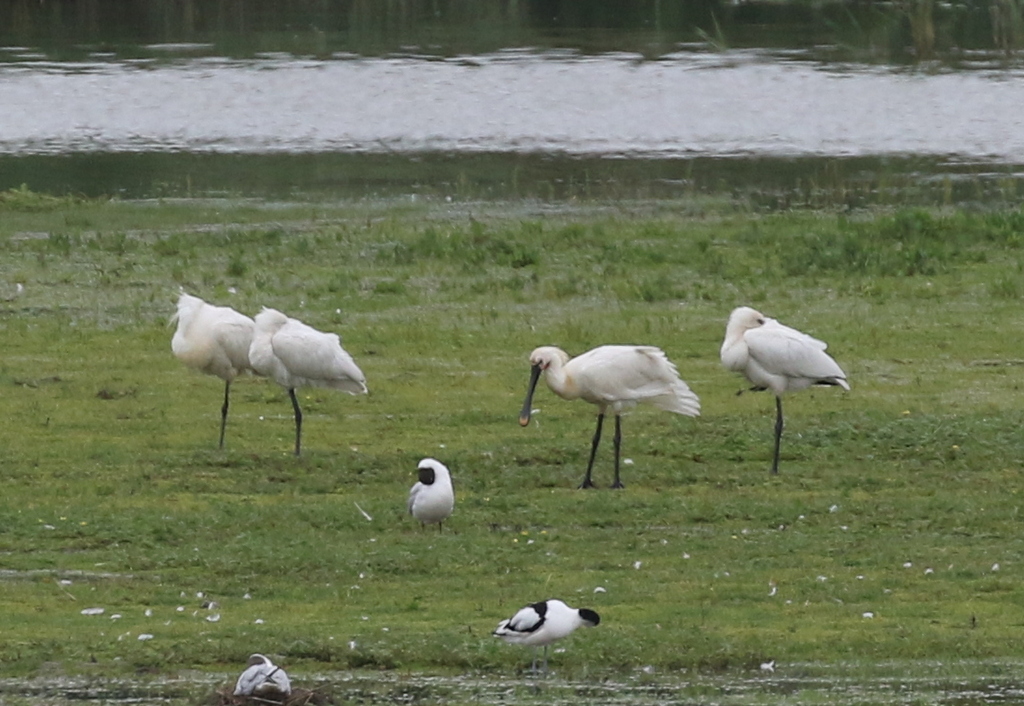
We had a better view over the Fen from up on the seawall. We got the Spoonbills and the various waders in the scope. But there was no much more visible from up here that we hadn’t seen on the walk out, a few Common Redshanks and a single Black-tailed Godwit which flew off soon after we arrived.
The tide was just going out in the harbour and we made our way on, past the end of the seawall and out to the corner of the coast path to have a scan. Two pairs of Shelduck were displaying down at the bottom of the grassy bank as we passed and looked like they might be still prospecting for nest sites.
A frenzy of Common Terns was gathered out over the middle of the harbour, presumably having found a shoal of fish. A Sandwich Tern was on one of the sandbars nearby, its partner returning periodically with a fish to present to it. There were not many waders out here yet, apart from the Oystercatchers which have spent the summer here. A single Curlew was out on the mud and two more flew over, more early returning birds. We could see a few seals pulled out on the shingle on Blakeney Point in the distance.
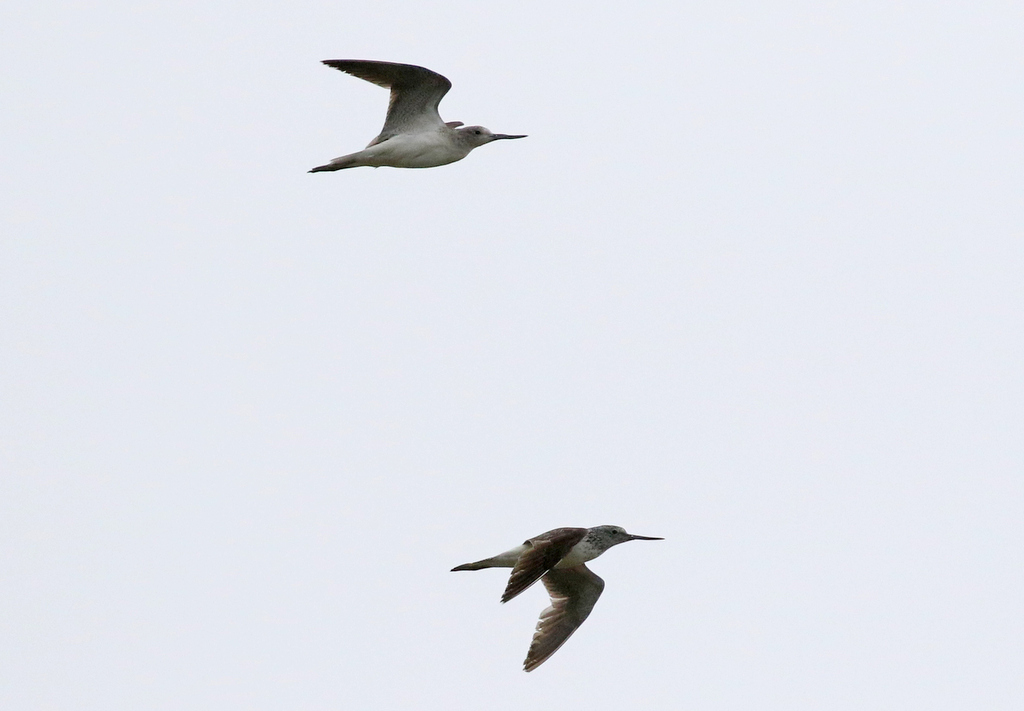
As we walked back to the seawall, a male Marsh Harrier flew in across the reedbed out out towards the edge of the saltmarsh. The Greenshanks started calling and took off, flying past us and out towards the harbour, presumably looking to feed again on the falling tide. On the way back along the path to the road, a Cetti’s Warbler flicked up out of the bushes by the river and disappeared into the willows, the sight of a chestnut tail disappearing into the vegetation being a typical view of a Cetti’s Warbler!
A Green-winged Teal had been reported this morning from the hides at Cley, so we thought we would call in there next, on our way past. As we walked out along the boardwalk, we heard a Bearded Tit calling and turned to see a male flying straight towards us over the reeds. It dropped across the path just ahead of us and disappeared straight into the reeds the other side.
We stood on the boardwalk where it had gone in and could see the reed moving as it worked its way through. It came back towards us, passed by just a few feet away but tucked down mostly out of view, before flying up and out again back across the boardwalk. A little further on, another Bearded Tit was more obliging, perched in the reeds with a large caterpillar in its bill. It didn’t seem to know quite what to do with it!

We went in to Teal Hide first, as the drake Green-winged Teal had been reported from Pat’s Pool earlier. There were quite a few Eurasian Teal swimming round on the water or asleep on the islands. After a short while, the Green-winged Teal swam out with the other Teal. It was busy feeding, with its head mostly down in the water, but we could see the distinctive thick white vertical stripe on the foreflank. Several drake Eurasian Teal were swimming with it, giving us a good comparison of the two species, the Eurasian Teal showing instead a horizontal white stripe.
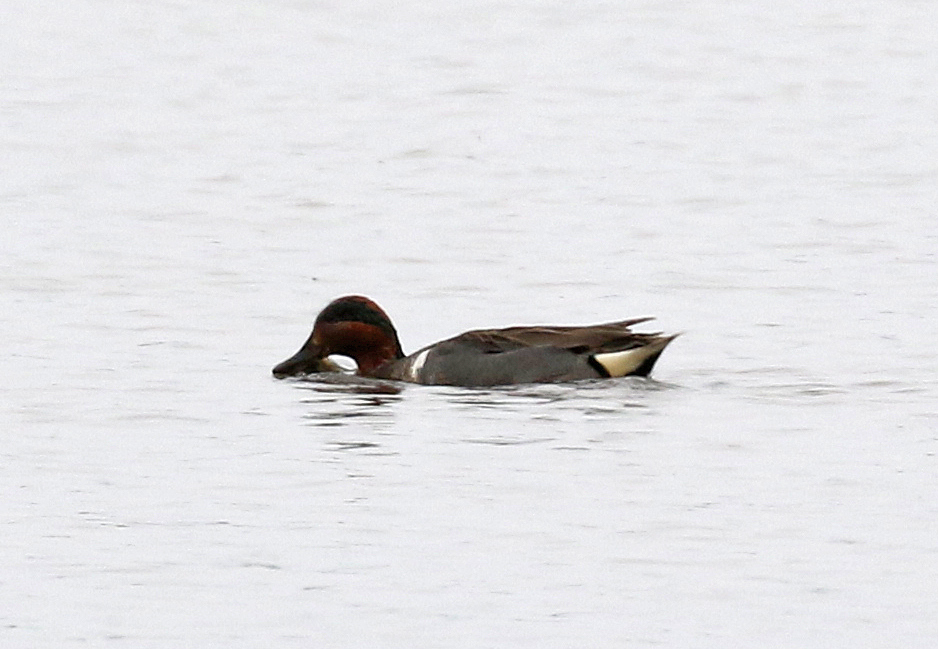
Green-winged Teal is the North American cousin of our regular Eurasian Teal, and is a scarce but regular visitor across this side of the Atlantic. Given the number of Eurasian Teal returning here at the moment, it seems most likely that the Green-winged Teal had come here with them, rather than arriving fresh across ‘the Pond’.
There was a nice selection of waders on the scrapes here too, split between Pat’s and Simmond’s. There were at least 120 Knot, hard to count exactly as they were mobile between the hides and kept splitting into different groups. Most of them were in grey non-breeding plumage, though there were two or three rusty birds in with them. They are probably 1st summer birds which have not bred this year.
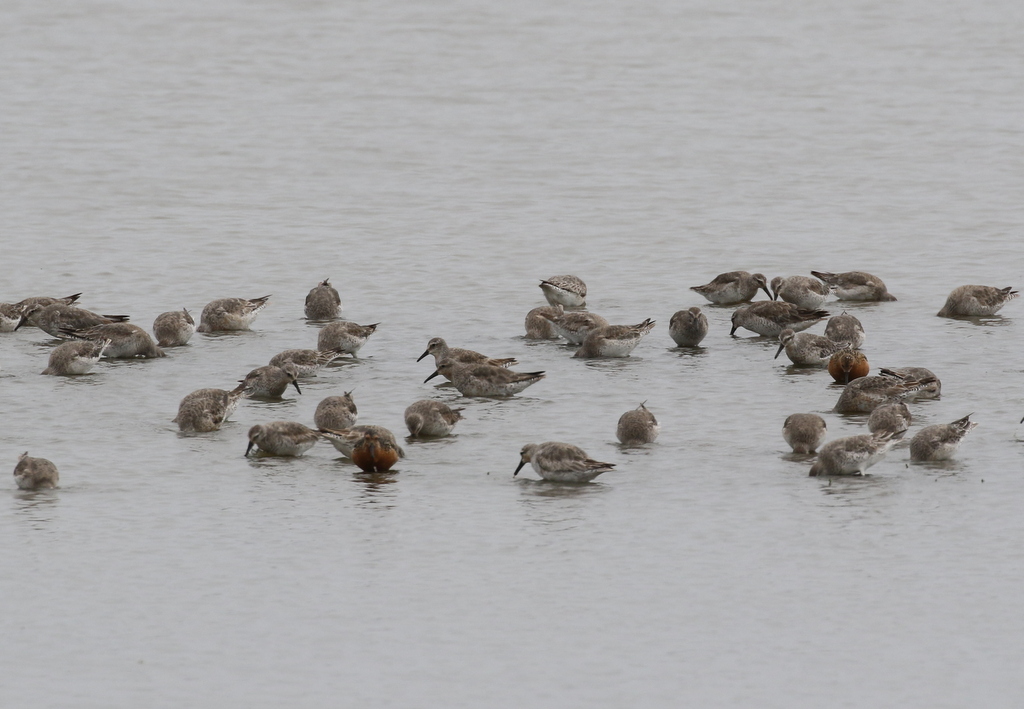
There were lots of Black-tailed Godwits too and looking through them we found a single Bar-tailed Godwit in amongst them, sleeping on the back of one of the islands. The Black-tailed Godwits are mostly Icelandic birds (of the race islandica), but there was a colour-ringed bird of the Continental race, limosa, in with them, a moulting adult. At one point, we had the Continental Black-tailed Godwit, the Bar-tailed Godwit and one of the Icelandic Black-tailed Godwits all in the scope together, giving us a great 3-way comparison.

While the population of Icelandic Black-tailed Godwits has been increasing, the Continental Black-tailed Godwit has been struggling. There are only about 40 pairs which breed in the UK, in the Fens on the Nene and Ouse Washes, where they are very vulnerable to summer flooding. They are the subject of urgent conservation action, through ‘Project Godwit’ and the headstarting programme.
It was time for lunch, so we made our way back to the Visitor Centre and made use of the picnic tables outside. A Green Sandpiper circled over calling while we were sitting there, possibly a fresh returning migrant. After lunch, we continued on our way east.
Our next stop was at Iron Road, where we had a quick look at the pool. It has filled up with water again after the recent rains, although there were no waders on here today, but it is always a good place to check when birds are on the move. As we turned to walk back to the minibus, a Barn Owl was out hunting over the marshes. It was a wet night last night and it probably has young to feed somewhere.

Our final destination for the afternoon was Kelling. A Greenfinch was singing from the top of the fir tree by the school as we set off along the lane, and there were a few Goldfinches and Chaffinches in the bushes, but otherwise the hedges were rather quiet here. When we got to the copse, we stopped to scan from the gate. There were lots of Brown Hares out on the hillside beyond, a couple of them sprawled out across the grass fast asleep. We had to get the scope on them to double check they were actually still alive!
The pool on the Water Meadow was very full of water, with no muddy edge suitable for waders now. The pair of Egyptian Geese still have two goslings which are getting very big now, not far off fully grown. A Common Whitethroat flew across to the brambles on one edge carrying food. Continuing on down towards the beach, there were a few Linnets and Meadow Pipits.
We took the permissive path up the hill towards the gun emplacements. Looking out to sea, a few Sandwich Terns flew past and a couple of Little Terns were fishing just offshore. Given the walk out had been rather quiet, we decided to continue on round on a circular walk back towards the village. A Marsh Harrier was hunting over the grassy field above the Water Meadow.
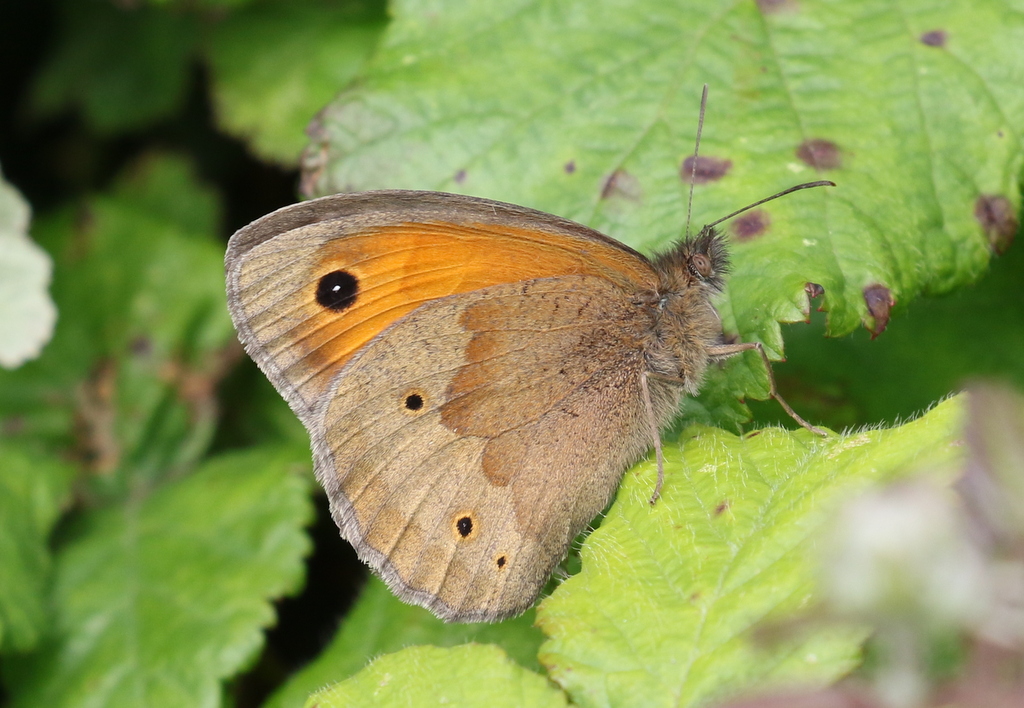
We had just remarked how few butterflies we had seen out today, when we started to find them. First we found a couple of Meadow Browns in the grass and nectaring on the brambles by the path. Then we started to come across Painted Ladys. There has been a noticeable invasion from the continent in the last week or so and we have been seeing large numbers most days. There were a few basking on the path but when we stopped to admire all the poppies growing in the strip left fallow at the top of the field we realised it was full of Painted Ladys.
By the time we got back down to the village it was time to call it a day and make our way back. We had seen a few of the different sites along the coast today, and we had even managed to squeeze in a few good birds on the way!
















